Menu
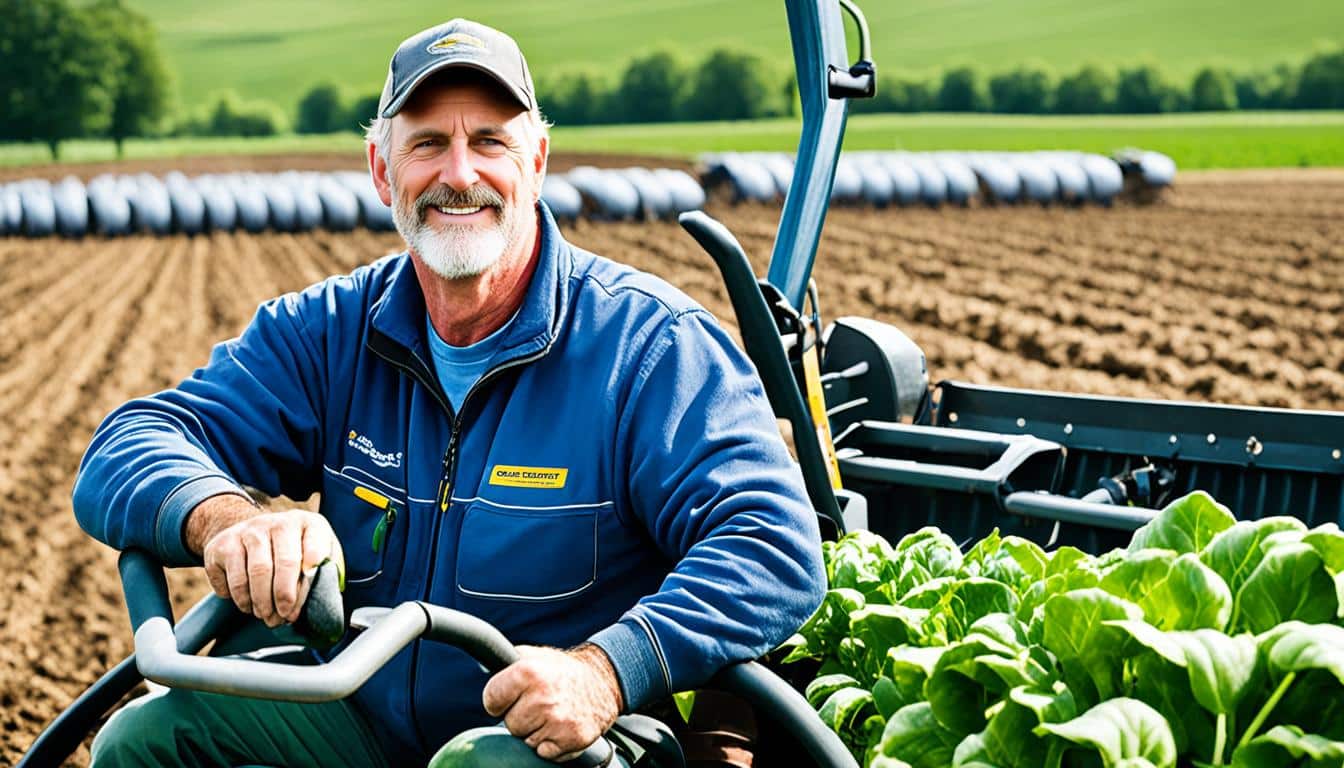
Did you know farm workers often get hurt from doing their jobs? About a third of these injuries are sprains and strains. Another quarter of these injuries are to the back. In California, farm workers face over 3,000 back injuries yearly. This costs more than $22 million in workers’ compensation. Farm work is hard and can lead to these injuries. This not only harms the worker but also reduces the farm’s earnings.
Ergonomics means making work easier and safer. The goal is to design jobs, places, and tools that best suit the person using them. The National Institute for Occupational Safety and Health (NIOSH) says following ergonomic rules can reduce many common farm injuries. By using ergonomics, we can make farms safer. This helps the workers stay healthy and makes the farms more efficient.
Ergonomics is the science behind how workers and their tasks fit together. It shows us how to make equipment and tasks work better for safety and efficiency. In farming, ergonomics is key to making hard work easier, cutting risks, and improving how much we can do.
Ergonomics mainly changes work areas and jobs to suit the workers. It keeps workers safe from getting hurt and facing health problems later. Around the world, the International Labour Organization says that 160 million people suffer from work-related health issues each year. Most of these problems are because of heavy lifting, bad postures, and doing the same movements over and over. Ergonomics can lower these health risks a lot.
Over time, ergonomics has become more important for keeping workers safe. Studies, like those from Hildebrandt in 1995, have shown that pain in the lower back and neck is common in farming. Up to half of the workers and employers in agriculture can have these pains. This shows how important ergonomics is for farming. It makes work safer and helps keep the workforce healthier.
Farm workers often face health issues due to their hard work. They are mostly affected by musculoskeletal disorders. These come from repeating the same movements, using force, or staying in odd positions for too long.
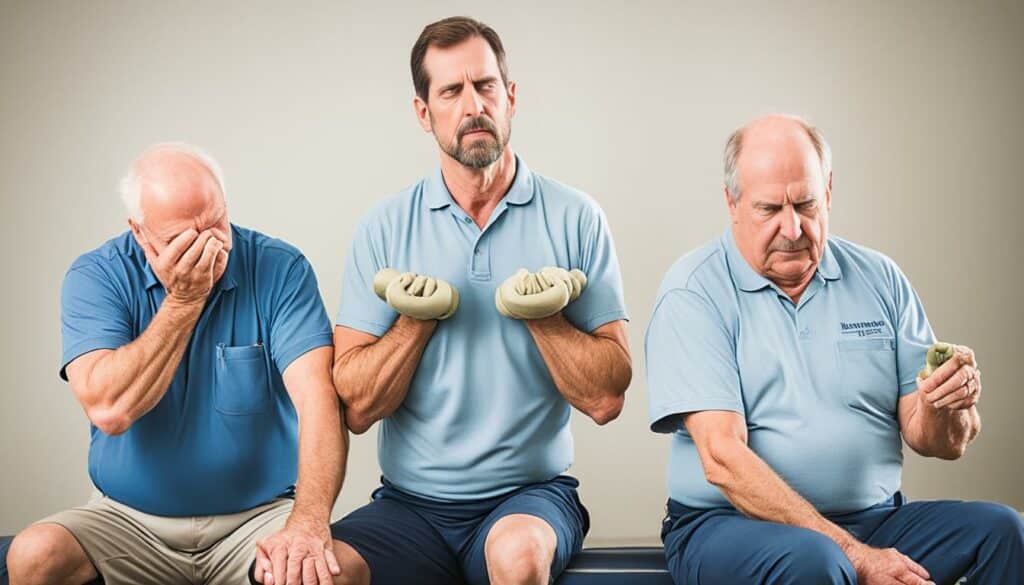
Musculoskeletal disorders are very common among farmers. About 90.6% of them experience it over their lifetime. In a year, 76.9% have these disorders. They cause a lot of missed work, showing that farm safety teaching and better tools are very important.
Looking closely at these injuries, we see that they cause pain in many areas. The most reported pain comes from the low back, affecting 63.8% of farmers. It’s clear we need to take steps to prevent these injuries.
Repetitive work, like lifting heavy things or working in odd stances, can cause muscle, tendon, and ligament strains. Severe symptoms often appear in hands, forearms, back, and hips. But, we can often avoid these injuries with the right ergonomic practices.
Backaches and joint pain are common on farms. They are made worse by tough jobs. Many studies show that farm work is physically straining. Back pain is a big issue and it affects daily work and health in the long run. To counter this, ergonomic solutions are crucial.
| Type of Injury | Prevalence (%) |
|---|---|
| Musculoskeletal Pain | 91.3 |
| Low Back Pain | 63.8 |
| Reported Missed Workdays | 76.9 |
| Overall Pain in Multiple Areas | 91.3 |
Farm safety training is key for improving workplace health. It includes teaching on how to move correctly, use tools right, and apply ergonomic methods. These practices boost health, productivity, and the future sustainability of farms.
Using ergonomic methods in farming is key to making work both healthier and safer. This involves changing how work areas and tools are set up. By doing this, we can cut down on the risks of getting hurt while working on the farm. This makes everything safer and more effective.
Farmers often have back, shoulder, arm, and hand pain. This comes from doing a lot of physical work in positions that strain the body. To help, we can make work areas better using ergonomic ideas. Making workstations the right height (33” to 43” depending on the person and job) stops muscle and joint problems. Having jobs where people sit instead of always standing can also help. Standing can make your lower back and legs hurt more than walking does.
Making tools easier to use is just as important for health at work. Tools need to fit comfortably in your hand, between about 1-3/8” to 2-1/8”. And their handles should be smooth and not easily slip to prevent hand strain. It’s also best if things you have to lift are kept near where you stand or between hand and shoulder height. This way, your body doesn’t suffer too much. Another problem is when farming vehicles shake a lot. Using vehicles that have seats that absorb these shakes can help people stay more comfortable while working.
NIOSH, a health and safety group, says these changes are a smart way to reduce how often people get hurt at work. By applying ergonomic thinking to both tools and work areas, farms can cut down on the number of injuries. This boosts how much work gets done and keeps everyone in good spirits.
Using ergonomics at work makes farms safer and cuts down on injury risks. It involves placing tools correctly and giving workers enough time to rest. This stops a lot of the usual work injuries and pains.
Putting tools in the right spot helps avoid muscle strain. It’s best to keep tools close, about 17 inches away. This stops workers from stretching too far.Tools shouldn’t go higher than where your shoulders are. This high placement can hurt the neck and shoulders. Also, jobs where you can sit down are better for the back and legs, especially for low tasks.
For tasks done standing, the table or bench should be 33” to 43” tall. This suits different jobs and body sizes well. The size of the handle on tools is also key. It’s good if there is a 3/8” space between your forefinger and thumb. The handle should be about 1-3/8” to 2-1/8” thick. This way, you can hold tools safely and comfortably, which lowers the risk of hand and arm injuries.
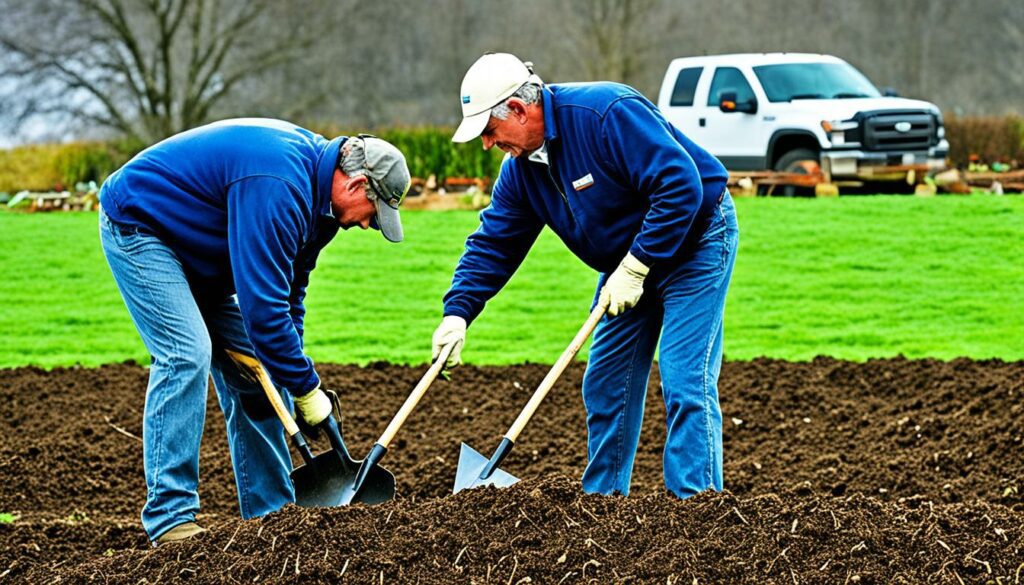
Giving workers enough time to rest during their shifts is vital. It helps avoid too much strain. Limits advise against lifting from the ground or above the shoulders. Try to keep bags under 50 pounds to make work easier.
If a job needs bending down, mix it with tasks that let you stand or sit. This stops tiredness and lowers the risk of back and leg issues. Using vehicles with seats that absorb vibrations also helps keep workers safe.
| Ergonomic Recommendations | Details |
|---|---|
| Tool Placement | Within 17 inches of the worker and below shoulder height. |
| Seated Jobs | Reduce lower back and leg strain. |
| Workstation Height | 33” to 43” depending on task and gender. |
| Tool Handle Size | 3/8” overlap between forefinger and thumb, diameter 1-3/8” to 2-1/8”. |
| Lifting Guidelines | Between hand level and shoulder level, weight below 50 pounds. |
| Recovery Time | Short tasks involving walking or sitting between stooped work. |
| Vehicle Ergonomics | Equipped with suspension seats to reduce whole-body vibration. |
Following these ergonomics tips makes the farm a safer, happier place to work. It keeps workers healthy and works smoothly.
It’s vital to follow good ergonomic practices when picking and using hand tools, especially on farms. Farm work can lead to backaches, shoulder pains, and hand pains. Knowing about hand tool ergonomics is key to avoid these health problems.
The right design of hand tools is crucial for worker comfort and to prevent injuries. Workplace ergonomics principles are used to make sure tools match the user’s natural grip and strength. Tools must have handles that fit the shape of the hand, making work easier and safer, key aspects of farm safety training.
The materials of hand tools also matter a lot for ergonomics. Tools should have covers that don’t slip and are smooth. This helps reduce the work needed and the chances of getting hurt.
Handle sizes and lengths are also important. They should be in certain sizes and lengths to reduce muscle tiredness. This makes the work more efficient, following workplace ergonomics principles.
Encouraging these ergonomic practices with hand tools can cut the risk of muscle and bone problems. These guidelines make work safer and improve productivity. This way, workers can stay healthy and avoid getting hurt.
In modern farming, ergonomics plays a vital part, especially in lifting jobs. Following ergonomic practices greatly cuts the risk of back strains. It makes sure farms are safe places to work.
It’s key to include safe lifting practices in farm safety rules. Workers need to understand why it’s important to lift between their hands and shoulders. This limit can help prevent back injuries.
A big part of farm injuries comes from lifting the wrong way. It’s important to stand correctly and lift things with your legs. This helps avoid risks related to ergonomics.
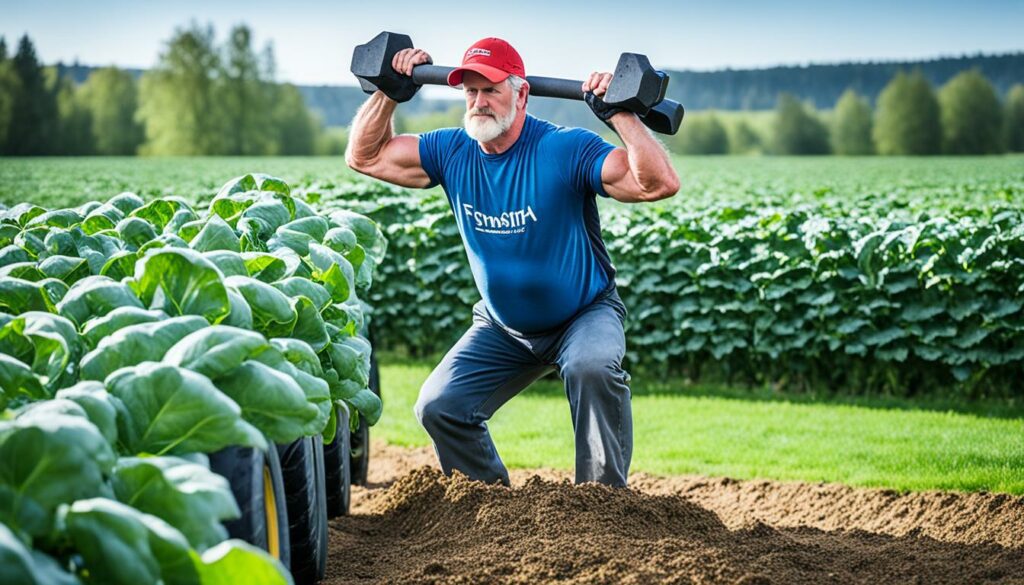
Using devices that help with lifting, like forklifts and hoists, is also vital. Such tools ease the burden on workers, lessening injury risks. In California alone, over $22 million is spent yearly on workers’ comp for back injuries.
So, applying ergonomic solutions isn’t just about safety. It can also save a lot of money. It’s good for the people and the pocket.
| Task | Ergonomic Solution | Impact |
|---|---|---|
| Lifting heavy loads | Use of forklifts | Reduction in back injuries |
| Frequent bending | Adjustable height workstations | Minimizes strain on lower back |
| Repetitive lifting | Conveyor belts | Decreases muscle fatigue |
Embracing ergonomic changes is vital for safer lifting. Proper training in ergonomics is key for workers’ safety and productivity. It’s all about matching the job to the person, making sure everyone is working safely and well.
In farming, people often have to work in stooped positions. This can lead to a lot of back pain. They also feel pain in their shoulders, arms, and hands. Working in these ways, like carrying heavy things or kneeling down, makes this pain worse. It also leads to more muscle and bone issues for people working on farms.
It’s key to have the right farming safety protocols. This helps reduce the dangers of working stooped. A simple change, like adding long handles to tools, can help people stand up straight. This lessens the pressure on their back and legs. Having stools at work also helps. It lets workers sit or stand as they need to. This helps them feel less tired and sore.
Some other things that help are floor mats and keeping lifts at the right height. Floor mats make standing work less tiring by 35%. They also make it more comfy and cut down the chance of getting hurt. Lifting things at the right level, like between your hands and shoulders, also stops common work injuries.
70% of farm workers get hurt because of bad ergonomics. But, following good ergonomics guidelines can lower this number a lot. Better ergonomics doesn’t just cut down on injuries. It also makes workers 20% happier and more productive.
| Ergonomics Adjustment | Benefits |
|---|---|
| Long Handles on Tools | Reduces back and leg strain |
| Provision of Stools | Allows alternation between sitting and standing; reduces fatigue |
| Floor Mats for Standing Workstations | Reduces fatigue by 35% |
| Lifts Between Hand and Shoulder Levels | Decreases lifting-related injuries |
Making the workplace healthier through ergonomics can make farming safer and more efficient.
Good vehicle ergonomics are vital for farm safety and the health of those working the land. Using features like suspension seats helps cut down on the bad effects of long vibrations. These include back pain, shoulder issues, and other body aches.
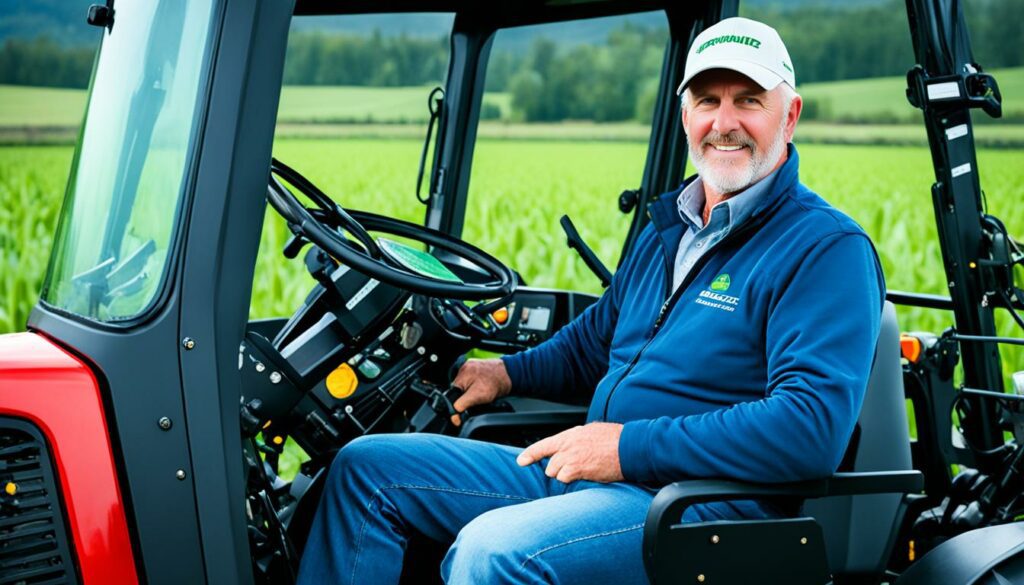
Suspension seats in tractors and farm vehicles are a must. They lower the body’s vibration levels. This helps fight off health problems like low back and neck pain, which often come from using machines for a long time. By using suspension seats, the impact of vibration on the body is lessened. This helps keep farmers healthy and the farm more productive.
Having the right posture support in vehicle seats is key to farm safety. It’s important that seats and supports are set up well in tractors and vehicles. This keeps the body in a good position and lowers the risk of spine and injury over time. Seats in farm vehicles should be able to change in different ways. They should have back supports and seat heights that adjust. This makes them suitable for everyone, keeping operators safe and comfortable.
Summing up, using features like suspension seats and good posture support in farm vehicles really makes a difference. It tackles issues with how we sit and helps ensure farm safety all around.
An ergonomic risk assessment in farms helps find and fix dangers to the workers. It looks at how people and their jobs fit together. The goal is to make work safer and more efficient by adjusting tasks, tools, and the workplace.
First, a careful look at the workplace is needed. This includes what the workers can physically do, the jobs they’re actually doing, and the tools they need. It’s crucial because workers often suffer from back pain and pain in their hands, arms, and shoulders. These problems can lead to more serious conditions like sprains, strains, and back injuries, causing them to miss work.
Each year, a third of work injuries that lead to missed work are due to sprains and strains, and a quarter are back injuries. In California, dealing with over 3,000 back injuries yearly costs more than $22 million. This shows how important ergonomic risk assessments are, both for physical health and the money farms spend on injuries.
It’s key to change tools and work methods with ergonomic principles in mind. Making these changes, and teaching workers to work safely, can lower the risk of injuries. Research supports this, showing that using specific assessment tools can help prevent the usual complaints like back and muscle pain among farmers.
| Injury Type | Percentage | Annual Cost (in CA Agriculture) |
|---|---|---|
| Sprains and Strains | 33% | $7.26 Million |
| Back Injuries | 25% | $22 Million |
Farms should make daily use of methods that ensure work is safe. Doing so protects the staff and improves their work and happiness. By focusing on better work settings and practices, we can keep our workers safe and keep the farm running smoothly.
Bringing in ergonomic practices can really improve farm safety. This is key since farm work often involves a lot of physical effort. It’s important for workers to learn about staying safe and being involved in safety practices.
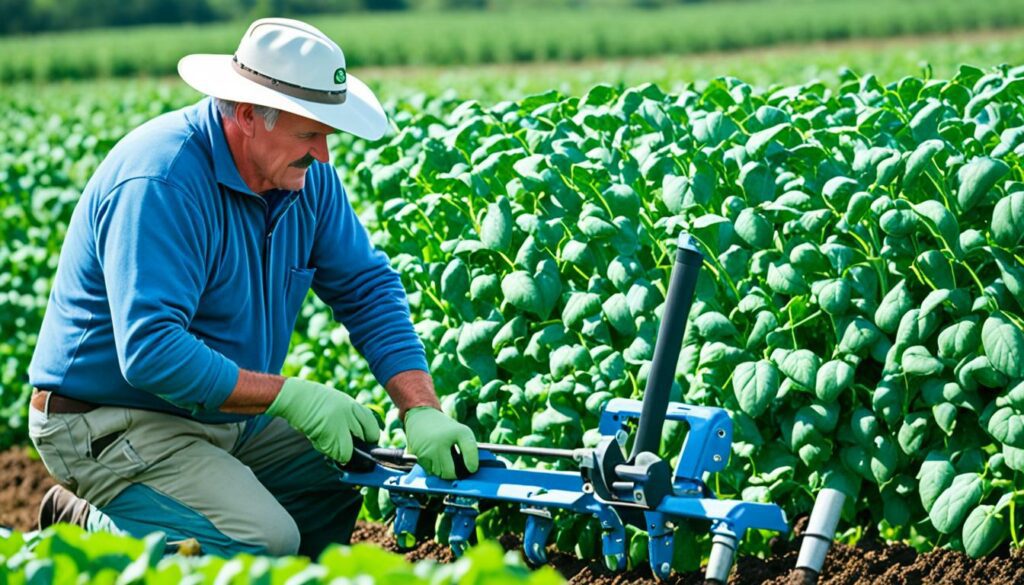
Training on farm safety is incredibly important. Many farm workers deal with back, shoulder, arm, and hand pain. They need to learn the right ways to work, from how to lift things safely to using tools correctly. Making simple changes helps prevent injuries by improving how they work and reducing stress on their bodies.
Getting employees to use these better ways not only boosts their health but saves money too. In places like California, yearly costs for workers’ back injuries can top $22 million. By tweaking tools or work setups, the risk of getting hurt can drop a lot.
Having workers take part is vital for safer farming. They should help find and fix places where injuries might happen. This way, they are not just following rules but actively making their workplace better. Problems like back pain are common but can be lessened by adjusting how tools are used.
Providing jobs where workers sit down can make a big difference. It lessens back and leg strain and reduces leg swelling. By giving out tools that fit well in hands, it also lowers the chances of painful conditions like carpal tunnel syndrome.
Ergonomic practices ensure that farm jobs match what workers can do safely. Everyone’s input is needed, from learning in safety sessions to suggesting better ways of working.
In the end, good ergonomic practices not only lower injury risks but also keep workers happy and the farm running smoothly.
| Initiative | Key Benefit | Impact |
|---|---|---|
| Training and Awareness Programs | Enhanced knowledge and application of ergonomic principles | Reduced backaches, sprains, and overall injury rates |
| Employee Involvement | Proactive participation in ergonomic improvements | Higher compliance and reduced WMSDs |
| Ergonomic Tool Redesigns | Minimised physical stresses and improved comfort | Decreased risk of carpal tunnel syndrome and other injuries |
How ergonomic practices are used in real life show their importance. They help make workplaces safer and more productive. Case studies teach us how to put these practices into action, especially in farming.
In some industries, ergonomic changes have made a big difference. At a die cast plant in Ohio, they cut costs and boosted production by a lot. With an initial spend of $495,500, they saved $1,910,000 each year for ten years. These figures show how using ergonomic methods can save money and make work better.
Deere and Company saw big improvements too. Their ergonomics training led to fewer back injuries and lower health care costs over ten years. This story proves that investing in ergonomic training makes employees feel better and saves money in the long run.
From these successes, agriculture can learn a lot. For a start, adding ergonomic practices can lower the chance of workers getting hurt. A study from the US Department of Labor in 2016 says that better workspace design and ergonomics might stop up to 30% of back injuries. This makes it clear: using ergonomic methods in farming is crucial for keeping workers healthy.
A case in a medical call centre is also telling. They had a high 15% injury rate, which they brought down to zero with ergonomic changes. These stories underline how important ergonomics are for making workplaces safer. By incorporating these practices, agriculture can also see benefits in safety and how well work is done.
| Case Study | Initial Investment | Annual Benefits | Outcome |
|---|---|---|---|
| Die Cast Plant, Ohio | $495,500 | $1,910,000 | 93% drop in workers’ compensation costs, 67% reduction in absenteeism, 54% increase in productivity |
| Deere and Company | Not specified | Not specified | 83% reduction in back injuries, 32% decrease in health care compensation |
Using ergonomic solutions in farming boosts worker health and helps financially. It cuts down on musculoskeletal disorders (MSDs). These often happen because farming is physically tough. So, farms save a lot by using ergonomics.

Things like small tubs for grapes and long-handled tools help fight MSDs. Back pain is a big issue for farm workers, more than in other jobs. This means we must use ergonomics to lower injuries and costs. The yearly healthcare cost for farm injuries is over $167 million, showing big savings from ergonomic changes.
Ergonomics also cut down on injuries, helping workers be more productive. It stops activities that can hurt, like bending a lot or lifting heavy stuff. Farm workers in California get hurt a lot, even more than what’s seen as high risk. By using ergonomics, we make work easier and safer, boosting how much work gets done. This is a win for workers and for profits in farming.
Using ergonomic practices in farming is key to keep workers healthy and prevent injuries. The hard work on farms often leads to musculoskeletal disorders (WMSDs). Symptoms include backaches, and pain in shoulders, arms, and hands, which are common. These problems can cause workers to miss work, which costs farms money. In California, over 3,000 back injuries lead to more than $22 million in compensation costs every year.
Ergonomics focuses on matching the human body’s abilities with job demands. Making tools and processes more ergonomic can prevent injuries. This includes better work postures and less physical stress. For example, placing tools within 17 inches of a worker reduces injuries. Also, using hand tools that fit well can cut down on hand tiredness. Providing jobs where workers can sit can also help reduce back and leg strain.
Stopping long-term injuries means using ergonomic solutions and teaching safe work habits. It’s important because tasks that require a lot of force or are done in awkward positions can harm workers. Repetitive tasks can also increase the risk of injury. Ergonomic designs that help with one crop can be used for other crops too. Changing how jobs are done, or adding short tasks, can also help. Using vehicles with better seats decreases the impact of whole-body vibration, thus protecting workers. By focusing on ergonomic farming, we can keep our workers safe and healthy for a long time.
Ergonomics makes farms safer. It tackles tough physical work, cutting injuries like back trouble. It changes work and tools to fit the worker, boosting how safely and well they work.
Ergonomics studies how work can be safe and effective. This is key in farming to stop injuries and make work easier and safer for farmers.
Knowing ergonomics’ past helps us see how farming safety has grown. It highlights improving rules to keep farmers safe from hard work.
Farmers often get muscle, back, and joint pains from hard, repeating work. They face these pains because of how they work every day.
By changing work areas to fit workers better, we cut down on hurtful work. This might mean changing table heights or comfy chairs. Making tools easy to reach also helps.
Making tools fit better can make a huge difference for farmers. Good tools feel good in the hand and help prevent accidents.
Tips like keeping tools close and having time to rest between jobs are crucial. They stop muscles from getting too tired and hurt.
A tool that’s well made and fits right keeps workers safe and comfy. Ergonomic tools lessen the chance of slipping and hurting because they’re right for the people using them.
Ergonomics teaches the best way to lift and use tools to move things safely. This stops back injuries and keeps the team well.
Changing tools or adding stools to tasks lowers the risk of back and leg issues. Such tweaks make bending work safer.
For machinery work, vehicle setup is vital. Good seats and posture support help farmers dodge harm from too much shaking.
Checking for safety risks early helps keep farms safe. This way, we can fix problems before they hurt someone.
Training and spreading awareness are key to getting ergonomics to work. They make safety part of farm life, with everyone doing their bit.
By looking at successful cases, we can learn a lot about good ergonomics. This knowledge helps others make farms safer and more comfortable.
Putting money in ergonomics saves later on, and it makes farms more productive. This is good not just for workers but for the whole business.
Ergonomics is about making work healther, and easier on the body. In the end, it keeps farmers from getting hurt, leading to a stronger and better farm team.